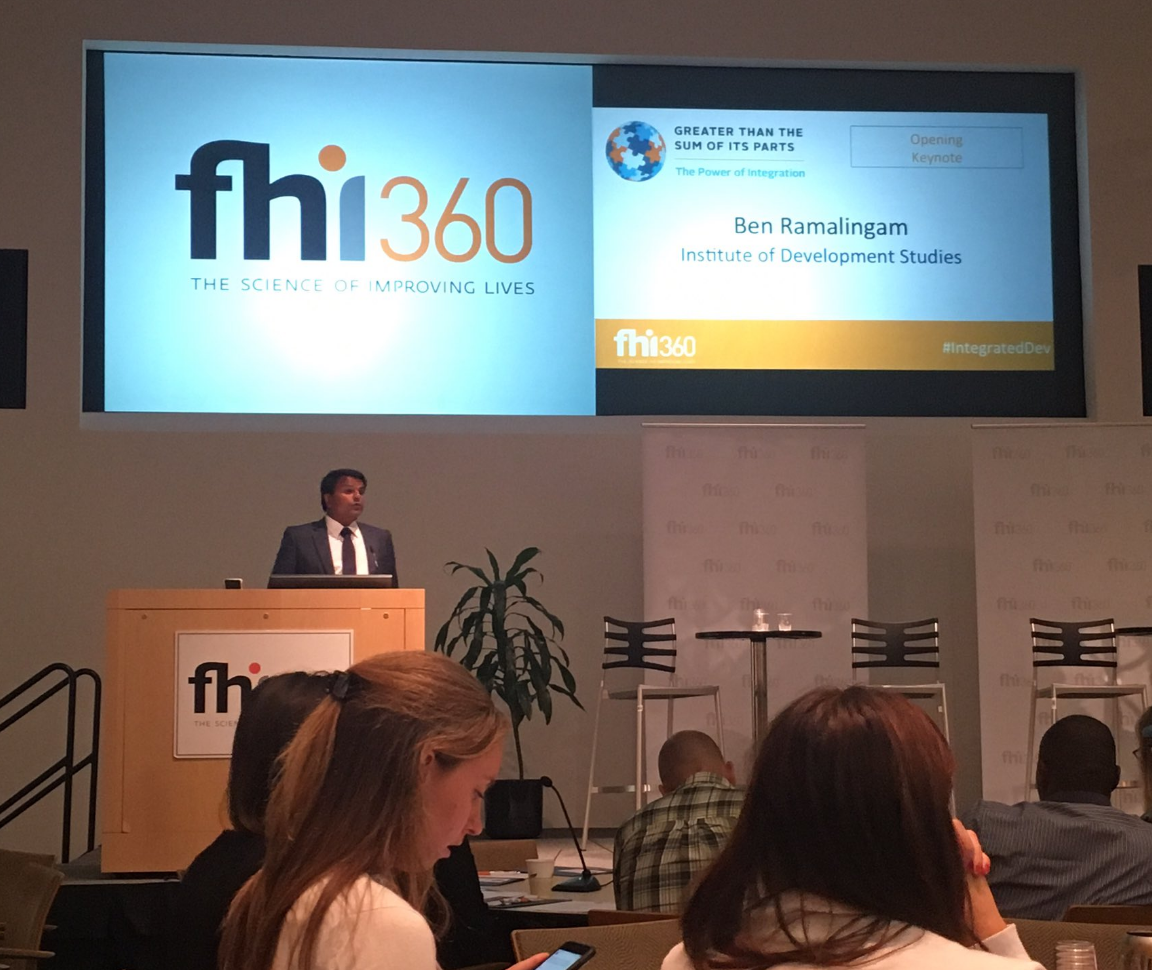Collaborating, learning, and adapting as a vehicle for integrated development
 Following the Ebola outbreak in West Africa, the international development and disaster management communities struggled to contain the virus for over two years. Not only did the virus claim over 10,000 lives, it also broke apart families and significantly weakened entire economies. What could have been done differently? During the integrated development summit hosted by FHI 360 on June 13, 2016, academic and author Ben Ramalingam argued that the outbreak represented a wicked problem, necessitating an integrated development approach. As the virus spread, global health professionals noted that those suffering from poverty were most vulnerable to Ebola--meaning it exacerbated inequality. However, interventions failed to holistically address the conditions that made people susceptible to Ebola in the first place. Why, he asked, does the international development community continue to respond with siloed solutions to such interconnected challenges?
Following the Ebola outbreak in West Africa, the international development and disaster management communities struggled to contain the virus for over two years. Not only did the virus claim over 10,000 lives, it also broke apart families and significantly weakened entire economies. What could have been done differently? During the integrated development summit hosted by FHI 360 on June 13, 2016, academic and author Ben Ramalingam argued that the outbreak represented a wicked problem, necessitating an integrated development approach. As the virus spread, global health professionals noted that those suffering from poverty were most vulnerable to Ebola--meaning it exacerbated inequality. However, interventions failed to holistically address the conditions that made people susceptible to Ebola in the first place. Why, he asked, does the international development community continue to respond with siloed solutions to such interconnected challenges?
The conference focused on moving the needle toward greater uptake of integrated development programs, with the goal of better development outcomes. The following constraints to integration were identified:
- Restricted funding and congressional earmarks: The way in which major funding mechanisms are set up shapes development. More flexibility could incentivize organizations to experiment with increased integrated programming.
- Sectoral expertise: How can a health-focused non-profit be expected to also tackle environmental rights? Integrating often means diversifying a team or organization’s expertise, which isn’t easy.
- Sector-specific government institutions: In most countries, government institutions tend to focus on one thematic area, hindering the ability for partner organizations to efficiently implement an integrated strategy. Meeting with multiple ministries to kick off an integrated project, for example, is time consuming.
Even in the face of these constraints, certain frameworks, mindsets, and practices can make integration easier. At the conference, speakers and participants alike identified collaborating, learning, and adapting (CLA) as a vehicle to facilitate integrated development. Below are some of the primary conclusions connecting CLA and integration that stood out:
CLA is required for integration to be effective
Robert Mwadime, representing FHI360 Uganda and the USAID-funded Community Connector Project (CC), highlighted that without CLA, integrated development becomes much more challenging and quite likely is not done well. CC’s adaptive mechanism permitted an integrated livelihood and nutrition intervention to roll out in modular phases. Monitoring, evaluation, and learning then fed into each new phase of the mechanism, shaping program design along the way. Given the complex nature and operating environment of integrated models like CC in Uganda, the mechanism itself and the principles of CLA allowed for more effective program delivery.
There are no silver bullets in international development
Development is extremely complex and there are no simple solutions to the challenges we are trying to address. Only through the application of innovative and multi-sectoral programs can we achieve the Sustainable Development Goals (SDGs), argued Susan Reichle, Counselor to USAID. The SDGs reflect a network of outcomes and goals that can only be reached through holistic approaches. A CLA approach, which includes practices like adaptive learning, strategic collaboration and context monitoring, creates an environment conducive to iteration and integration. This allows development practitioners to work within rather than in spite of the unique circumstances each development challenge presents.
The elements needed for CLA and Integrated Development to work are the same
In relation to integration, the following concepts kept coming up: strong leadership support, a cadre of change agents or champions, and flexible funding mechanisms all make integrated programming easier. These elements also make CLA more likely to be adapted by individuals and organizations according to the research we’ve done at LEARN. Essentially, both approaches need the same catalysts to thrive and evolve.
And finally, why does any of this matter? We hope that CLA and integrated development will contribute to better development results, a shorter recovery time in the face of another Ebola outbreak, or improved quality of life for over one billion people living in extreme poverty. Ultimately, as one conference participant mentioned: we shouldn’t fall in love with our projects, but rather with the goal of making our world better.



